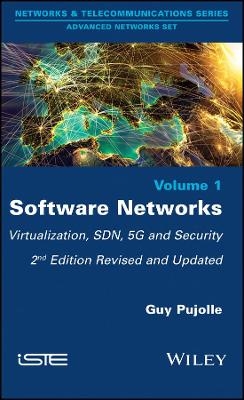
Software Networks
ISTE Ltd and John Wiley & Sons Inc (Verlag)
978-1-78630-458-2 (ISBN)
This book describes how to create and delete virtual networks on the fly. Indeed, the system is able to create any new network with any kind of virtual resource (e.g. switches, routers, LSRs, optical paths, firewalls, SIP-based servers, devices, servers, access points, etc.). Software Networks shows how this architecture is compatible with new advances in SDN (Software Defined Networking), new high-speed transport protocols such as TRILL (Transparent Interconnection of Lots of Links) and LISP (Locator/Identifier Separation Protocol), NGN, IMS, new generation Wi-Fi, and 4G/5G networks. Finally, the author introduces Clouds of security and the virtualization of secure elements (smartcards) that could certainly transform how to secure the Internet.
For this second edition, the author addresses in five new chapters the importance of open source software for networks, mobile edge computing, fog networking, tactile internet a network environment allowing remote access, and security the use of Cloud of security, secure elements and the emergence of the blockchain.
Guy Pujolle is currently Professor at Sorbonne University in France. He has published widely in the area of computer systems modeling and performance, queuing theory, high-speed networks, intelligence in networking, wireless networks and Post-IP networks, including 19 influential texts and monographs in these areas.
Introduction xi
Chapter 1. Virtualization 1
1.1. Software networks 4
1.2. Hypervisors and containers 6
1.3. Kubernetes 8
1.4. Software networks 9
1.5. Virtual devices 11
1.6. Conclusion 12
Chapter 2. SDN (Software-Defined Networking) 13
2.1. The objective 14
2.2. The ONF architecture 16
2.3. NFV (Network Functions Virtualization) 21
2.4. OPNFV 23
2.5. Southbound interface 23
2.6. The controller 25
2.7. Northbound interface 26
2.8. Application layer 27
2.9. Urbanization 28
2.10. Conclusion 30
Chapter 3. Fabric, SD-WAN, vCPE, vRAN, vEPC 33
3.1. Fabrics control 33
3.2. NSX and VMware company 35
3.2.1. CISCO ACI (Application Centric Infrastructure) 39
3.2.2. OpenContrail and Juniper 40
3.2.3. Brocade 42
3.2.4. Nokia’s SDN architecture 43
3.3. SD-WAN 43
3.4. vCPE 47
3.5. vRAN 48
3.6. vEPC 49
Chapter 4. Open Source Software for Networks 51
4.1. Open source software 51
4.2. Open Compute Project (OCP) 53
4.3. OPNFV 54
4.4. ONAP (Open Network Automation Protocol) 61
4.5. Open vSwitch 64
4.6. OpenDaylight platform 65
4.7. FD.io 66
4.8. PNDA 67
4.9. SNAS 68
Chapter 5. MEC 69
5.1. eNodeB and gNodeB virtualization 70
5.2. C-RAN 74
Chapter 6. Fog Networking 79
6.1. Fog architectures 79
6.2. Fog controllers 82
6.3. Fog and the Internet of Things 86
6.4. Conclusion on the Fog solution 87
Chapter 7. Skin Networking 89
7.1. Skin networking architecture 89
7.2. Virtual access points 90
7.3. Software LANs 92
7.4. Participatory Internet 94
7.5. Conclusion 96
Chapter 8. Software Network Automation 97
8.1. Automation of the implementation of software networks 97
8.2. Management of a complex environment 99
8.3. Multi-agent systems 101
8.4. Reactive agent systems 105
8.5. Active, programmable and autonomous networks 107
8.6. Autonomic networks 109
8.7. Conclusion 113
Chapter 9. New-generation Protocols 115
9.1. OpenFlow 117
9.2. VXLAN 123
9.3. NVGRE 124
9.4. MEF Ethernet 125
9.5. Carrier-Grade Ethernet 126
9.6. TRILL (Transparent Interconnection of a Lot of Links) 129
9.7. LISP (Locator/Identifier Separation Protocol) 131
9.8. Conclusion 132
Chapter 10. Mobile Cloud Networking, the Mobile Cloud and Mobility Control 133
10.1. Mobile Cloud Networking 133
10.2. Mobile Cloud 137
10.3. Mobility control 139
10.4. Mobility protocols 143
10.4.1. Mobile IP or MIP 144
10.4.2. Solutions for micromobility 145
10.5. Multihoming 146
10.6. Network-level multihoming 148
10.6.1. HIP (Host Identity Protocol) 149
10.6.2. SHIM6 (Level 3 Multihoming Shim Protocol for IPv6) 150
10.6.3. mCoA (Multiple Care-of-Addresses) in Mobile IPv6 151
10.7. Transport-level multihoming 153
10.7.1. SCTP (Stream Control Transmission Protocol) 153
10.7.2. CMT (Concurrent Multipath Transfer) 157
10.7.3. MPTCP (Multipath TCP) 159
10.8. Conclusion 160
Chapter 11. Wi-Fi and 5G 161
11.1. 3GPP and IEEE 162
11.2. New-generation Wi-Fi 163
11.2.1. Wi-Fi 5 (IEEE 802.11ac) 164
11.2.2. IEEE 802.11ad 166
11.2.3. IEEE 802.11af 167
11.2.4. Halow (IEEE 802.11ah) 168
11.2.5. Wi-Fi 6 (IEEE 802.11ax) and super WiGig (IEEE 802.11ay) 169
11.3. Small cells 170
11.3.1. Femtocells 171
11.3.2. Hotspots 174
11.3.3. Wi-Fi Passpoint 175
11.3.4. Virtualization of Wi-Fi and HNB 179
11.3.5. Backhaul networks 182
11.4. Software radio and radio virtual machine 184
11.5. 5G 185
11.5.1. 5G radio 189
11.5.2. The core network 192
11.5.3. C-RAN 193
Chapter 12. The Internet of Things 197
12.1. Sensor networks 198
12.2. RFID 200
12.3. NFC (Near-Field Communication) 204
12.4. NFC contactless payment 206
12.5. HIP (Host Identity Protocol) 207
12.6. Healthcare Internet 207
12.7. Case study: the smart city 210
12.8. Conclusion 213
Chapter 13. Vehicular Networks 215
13.1. 5G 217
13.2. 5G standardization 220
13.2.1. 5G vehicular networks 220
13.2.2. Technological presentation of C-V2X 222
13.3. VLC 224
13.4. Conclusion 226
Chapter 14. Tactile Internet 227
14.1. Tactile internet applications 227
14.2. Functionalities required for the tactile internet 229
14.3. Technical specifications for 5G 232
14.4. Tactile internet in Industry 4.0 234
14.5. Conclusion on tactile internet 235
Chapter 15. Security 237
15.1. Secure element 239
15.2. Secure elements-based solution 242
15.2.1. Virtual secure elements 242
15.2.2. The TEE (Trusted Execution Environment) 244
15.2.3. TSM 245
15.2.4. Solution without a TSM 249
15.2.5. HCE 250
15.2.6. Securing solutions 250
15.3. The blockchain 256
15.4. Conclusion 257
Chapter 16. Concretization and Morphware Networks 259
16.1. Accelerators 260
16.2. A reconfigurable microprocessor 261
16.3. Morphware networks 266
16.4. Conclusion 268
Conclusion 269
References 271
Index 273
| Erscheinungsdatum | 19.02.2020 |
|---|---|
| Verlagsort | London |
| Sprache | englisch |
| Maße | 163 x 236 mm |
| Gewicht | 635 g |
| Themenwelt | Mathematik / Informatik ► Informatik ► Netzwerke |
| Technik ► Elektrotechnik / Energietechnik | |
| ISBN-10 | 1-78630-458-9 / 1786304589 |
| ISBN-13 | 978-1-78630-458-2 / 9781786304582 |
| Zustand | Neuware |
| Haben Sie eine Frage zum Produkt? |
aus dem Bereich


